| |

Tower Jukebox
Tower
Calendar
TDN
Archive Search
Viewer
E-mail
Advertise
With Us
TDN Masthead
Well Built
Web Page!

Top
National Stories
Fresno News
Arts & Culture
Offbeat News

Bulldog News
California Star
Clovis Free Press
Daily Republican
Fresno Republican
Mother Wired
Reagan Library
SierraPortal.com
ValleyPress.com
WebPortal.com
Yosemite News

Yosemite Bookstore
Ahwahnee Hotel
Clovis Planetarium
Your Fresno Broker
FresnoIncomeProperty
Majestic Pawn
PC Paramedics
Presentations
Inc.
Roger
Rocka's
The 2nd Space
|
|
 |
|


January 27, 2007
Tower Sidewalks
Get Tree Makeover
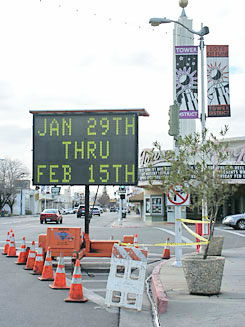 Olive
Avenue is going to be undergoing some big changes starting this
week. Our Tower groups have been working with the city on a major
street tree project that is going to create some long-term improvements
along our primary pedestrian corridor, but will also entail a little
bit of pain in the short-term. Olive
Avenue is going to be undergoing some big changes starting this
week. Our Tower groups have been working with the city on a major
street tree project that is going to create some long-term improvements
along our primary pedestrian corridor, but will also entail a little
bit of pain in the short-term.
We are going to be creating brand new street tree wells (the tree
wells are the holes cut in the sidewalk around the trees) for 19
of our street trees, complete with cast iron tree well covers.
The new tree well covers will vastly improve the look of the tree
wells, reduce the danger of people stepping into the wells and
twisting their ankles, and increase the usable area of the sidewalks.
Additionally, we will be planting new trees in each of the new
and improved wells. The tree wells that will be renovated are on
both sides of Olive Avenue, between Wishon and Lucerne.
The most painful part of this project is that the city will be
removing all of the existing trees in the wells that will be receiving
the improvements. We have consulted with over half a dozen tree
specialists and they all agree that the current trees we have on
Olive, Bradford Pears, are a poor choice for street trees. Several
of them are missing, many of them are sick and infested, most of
them haven't grown well, and those that do grow well tend to grow
large side branches that eventually break off and fall, creating
a real hazard for anyone or anything under them. Additionally,
the roots of the Bradford Pears tend to lift up the sidewalks,
creating a tripping hazard.
While we hate the idea of removing any trees, especially the full-grown
trees, we know that in the long run, this will be best for the
neighborhood. The new trees will be Chinese Pistachios. These trees
do very well in an urban environment, are beautiful, grow quickly
and will soon provide beautiful shade canopies.
The other slightly painful part of the process will be the fact
that the new tree well covers will be raw iron and will have to
go through a period of rusting. Initially, we will have to deal
with them developing an orange, powdery coating. However, once
they go through the rust stage, they will soon begin to mellow
into a rich, bronze coloring, just like the color of the manhole
covers in the street.
The project is scheduled to begin this week and should only take
about 3 weeks to complete. While the work is going on there will
be some disruption to auto and foot traffic, but again, the end
results will be spectacular.
[Editor's Note: Improvement project information provided by Bill
Kuebler, of the Tower Trust/Tower Distric Specific Plan Implementation
Committee.]

TowerDistrictNews.com
|
 |
~ Update ~
January 15, 2007
Tower Theatre District
The Best Kept Sequel in Fresno!
By Thomas Hobbs, Staff Writer
TOWER -- That certain Tower
District feeling of pride, place and historic
import has returned to these 1930's sidewalks and storefronts.
Some people are immune to it. What others say is that,
deep-down, it's like the feeling in your gut when
the traffic's moving, curbside parking is jammed, business is happening and
streets with names like Broadway, Fulton, Wishon and Van Ness hurriedly
deliver carloads of people to the
Tower Theatre, returning to the newly spruced-up village the
hangout where William Saroyan called "home." If you haven't visited
lately, you should. I get the feeling here, this place is in full renaissance.
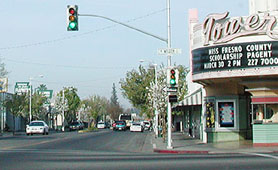 There
have always been two Towers. There's the Tower
in our minds, a fantasy
of
Hollywood
celebrity, past and present, that by now seems almost
encoded into the collective ArtDeco consciousness of Ayn
Rand. And there's the actual Tower District village, with its legendary Wishon
and Olive corner and famous places such as the Off Broadway 2nd
Space Theatre & Roger
Rocka's Dinner Theatre, and Good
Company Players Theatre. In contrast Downtown Fresno, a mile or so away,
has been the greatest disappointment for thirty years, at best. There
have always been two Towers. There's the Tower
in our minds, a fantasy
of
Hollywood
celebrity, past and present, that by now seems almost
encoded into the collective ArtDeco consciousness of Ayn
Rand. And there's the actual Tower District village, with its legendary Wishon
and Olive corner and famous places such as the Off Broadway 2nd
Space Theatre & Roger
Rocka's Dinner Theatre, and Good
Company Players Theatre. In contrast Downtown Fresno, a mile or so away,
has been the greatest disappointment for thirty years, at best.
Once upon a time, the Tower District was a vital
peripheral to the university
campus attracting intellectuals, classical jazz, and dance band musicians,writers,
intellectuals of every stripe. It was the essence of an upscale small college
town where the cafes like Irene's were
crowded by day with  Fresno
State College students drinking coffee or grabbing lunch at the College Pharmacy lunch
counter while carrying on serious discussions on the latest news from the War
in the Pacific or "meaning of life" or the possible ramifications
of Sigmund Freud's constructs he named Id and Ego. Fresno
State College students drinking coffee or grabbing lunch at the College Pharmacy lunch
counter while carrying on serious discussions on the latest news from the War
in the Pacific or "meaning of life" or the possible ramifications
of Sigmund Freud's constructs he named Id and Ego.
In those days, like today, most college students had
to work to help offset college costs. My family was no exception. Swing piano music
played on the Tower Jukebox in cafe's, especially in the Carnation
Ice Cream Restaurant on Broadway and Olive. My dad was the "soda-jerk" at
the Carnation Fountain and was also known as the "Tower
Box Boy" later when he worked the Black's Market grocery packing
counters, directly across the street.
A lot has changed, since then. But, a lot of people are
noticing, lately that the Tower District streets, merchants, and surrounding
neighborhoods are gathering a host of new devotees and those spacious mansions
and small apartment houses with orange groves of the 1930's, somehow, seem magically
to have reappeared.
I hear talk in the local coffee houses that even in its
heyday with its upscale boutiques and restaurants, it could not complete with
some people's expectations...More! |
 |
Sunday March 21, 2004
SPRINGTIME
IN THE
TOWER THEATRE DISTRICT
by Tom Hobbs,
Staff Writer
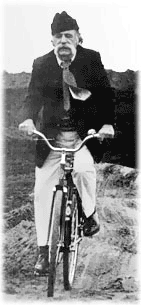 TOWER THEATRE DISTRICT
TOWER THEATRE DISTRICT
-- What is the Tower? My friend William Saroyan defined it. He invented
it. He wrote stories and sketches about Fresno's spirit and hometown
atmosphere. And that's the way it still is. Deep down, Tower People
are from around here and from all over the world. But when you're
in this this part of town, you're home at last.
People from all over the world come here
to read William Saroyan.; It's in every smile from passers bye,
every nod and greeting. Things are good again!
Today, there is probably no place better
known than is the Tower for his books being read, his plays performed,
his movies shown.
Ironically, today the Tower District a
beacon for the arts.
Fewer still know of his importance in making
the Tower District a place worthy of listing on the Register
of Historic Places. It was his favorite watering-hole and hanging-out.
He was that world famous writer who spent his formative years in
the Tower District. Later in life he was known in Paris and London,
New York, and San Francisco. He brought honor to us and a Pulitzer
Prize for his trouble.
People in the Tower District read his book
and plays and most have seen his Hollywood films, as well. Several
of Saroyan's works were based upon his personal experiences in Tower
District and University Village, as it was known in the 1930's.
He found his strongest themes in the spirit of the neighborhood,
he praised the freedom here, and declared its kindness and brotherly
love as human ideals for the entire world.
The Tower District still attracts writers
and playwrights from all over the world. Writers and editors for
the Tower District News got their start from Saroyan right here
in the 1950's. Howard Hobbs, PhD, the TDN Editor & Publisher
grew up in this neighborhood and was well acquainted with Bill Saroyan
who was known in those days as the dispassionate observer
who is everybody's best friend -- the ethic that made Tower
the way it was and what remains today.
The public record shows Saroyan was born
in Fresno as the son of an Armenian father trained to be a minister
in the Presbyterian Seminary. However, after arriving in
New Jersey the family moved to Southern California where his father
was forced to take on manual farm-labor work to feed his family.
His father died in 1911. William Saroyan
was put in an orphanage in Alameda with his brothers. Six years
later the family reunited in Fresno. At the age of fifteen, his
mother showed him some of his father's diaries and sermons. After
reading them the younger Saroyan decided to become a writer, himself.
Saroyan continued his education by reading
books he obtained from the Carnegie Library in Fresno and found
a means of earning money by writing stories from his own experiences
in Fresno.
He hawked late editions of a local
newspaper as a newsboy on the Republican Corner at Van Ness
and Fresno streets. He was later hired as a journalist by the newspaper.
He soon found he was capable of making a living on income from sales
of his writing.
It was 14 years later that he found a publisher
for his manuscript of "The Daring Young Man On The Flying Trapeze,"
a story of an impoverished young Armenian writer during the economic
depression of the 1930's in Fresno.
Saroyan was a playwright whose work was
drawn from deeply personal sources. The context of his knowledge
was the human interaction near Fulton and Van Ness
streets.
What he learned in University Village
was that the community was in transition. He was right. The
Village would soon give rise to the Tower District. It became the
essence of an upscale hang-out for an eclectic mix of college
crowd and local residents of a vital neighborhood on the move.
People began to buy land and houses north
of University Ave. The movement to suburbia gained its
zenith with the construction of the Tower Theatre in 1939. The
Tower was suddenly sophisticated and it had arrived.
One of Saroyan's best-known plays was published
that year. The Time of Your Life! (1939) won a Pulitzer
Prize. Closely following on this was sale of movie rights to
his short story My Name is Aram in 1940. He then sold the
film script of The Human Comedy, to MGM.
His movies were once shown in the Tower
Theatre. He was once acclaimed in Tower coffee shops as a model
for writers at Fresno State College just a few blocks away.
Later, Saroyan would publish essays and
memoirs on themes and people he had encountered in the Tower District
and while traveling in Europe. In the late 1960s and again in the
1970s he produced works that earned him substantial income and increased
worldwide acclaim.
Among the newer works were autobiographical
sketchbooks. In his later years he moved back to Fresno acquiring
a modest bungalow not far from his beloved Tower District of the
old days.
He had used his old Schwinn Bicycle
for transportation to the Carnation Ice Cream Fountain on
Olive. He would peddle that Schwinn bike of his all the way down
West Ave. to Shaw where Swenson's Ice Cream Parlor welcomed
him. He parked his Schwinn outside and walked in. He spoke a greeting
to me and asked how I'd been. He ordered an ice cream. He smiled
as he told me. We spoke of the good times. That was the last
time I saw him. Saroyan died on May 18, 1981 at home in Fresno. Saroyan's
mind and spirit still live on in the Tower Theatre District. Come
see!
[Editor's Note: Saroyan's personal memoirs
express his life vision as shaped by his own experiences in University
Village and The Tower District. His later books are
The Bicycle Rider (1952), Here Comes, There Goes, You Know
Who (1961), Not Dying (1963), and Obituaries (1980),
was nominated for the American Book Award.
His final work of reminiscence, Births (1983), was published
posthumously.]
COMMENT
©2004 The Tower District News.
All rights reserved.

TowerDistrictNews.com |

|
Saturday July 17, 2004
Steward of Tower District Namesake Dies
at 70
By Thomas Hobbs, Staff Writer
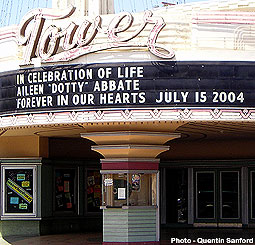 TOWER
DISTRICT -- Aileen "Dotty" Abbate, owner and executive
director of the Tower Theatre for the Performing Arts,
has died after a long illness. TOWER
DISTRICT -- Aileen "Dotty" Abbate, owner and executive
director of the Tower Theatre for the Performing Arts,
has died after a long illness.
Imagine what Fresno might
be like without the Tower Theatre as a cultural centerpiece.
Before Abbate became the owner, the theatre and surrounding property
were slated to become a parking lot.
Mrs. Abbate’s restoration
of the Tower Theatre, completed in 1989, resulted in the local
landmark being listed on the National
Register of Historic Places. Abbate's vision and support
laid the cornerstone that reestablished Fresno and the Tower
District as Central California’s Mecca for cultural arts,
fine dining, and entertainment.
Today, the Tower
Theatre provides a broad spectrum of arts and entertainment,
including top performing artists in music, dance, film, drama,
musical theatre, stagecraft, performance art, storytelling, symphony,
pantomime, puppetry, magic and more.
"She was a wonderful woman. She
had a real love for Fresno and the Valley," sources quoted
Hannah Benson, owner of The
Daily Planet restaurant which adjoins the theatre.
Mrs. Abbate died at home on Thursday,
only five days after her 70th birthday, surrounded by her family
and close friends. She is survived by her son Jim, two daughters,
Andrea of Los Angeles and Alyse Knight of Fresno; and two other
sons, Hal Jr. of Fresno and Laurence of Coarsegold; and nine
grandchildren.
Funeral services will be at 1 p.m.
Tuesday at St. Therese Catholic Church. Remembrances may be sent
to American Cancer Society, 2222 W. Shaw, Suite 201 Fresno, CA
93721. The Lisle Funeral Home is in charge of arrangements.
©2004 Tower District News.
All rights reserved.

TowerDistrictNews.com |
 |
| Friday
February 20, 2004
Tower Theatre
Covers VIA Magazine
By Josh Sens, The Traveler's Companion
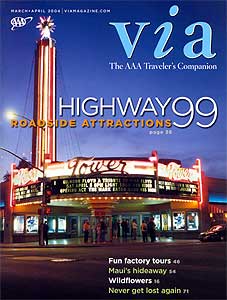 TOWER
DISTRICT -- Today Via
Magazine hit the streets in every California city over the weekend.
It's Volume 125, the March-April Issue of the publication featuring
sexy Fresno's historic landmark the Tower
Theatre for the Performing Arts on its cover. TOWER
DISTRICT -- Today Via
Magazine hit the streets in every California city over the weekend.
It's Volume 125, the March-April Issue of the publication featuring
sexy Fresno's historic landmark the Tower
Theatre for the Performing Arts on its cover.
In 1984, the year Fresno earned the dubious
distinction of being named the "least livable" city in
the United States, its mayor, Dan Whitehurst, appeared on Late Night
with David Letterman. When Letterman asked Whitehurst what there
was to like about Fresno, the mayor pointed out that the temperature
rarely rose above 120 degrees. What's more, Whitehurst added, it
was the first city in the country to institute "comprehensive
leisure suit control laws." Letterman chuckled. The audience
loved it. But Fresno has managed to have the last laugh.
Nearly 20 years later, this unassuming
city is both livable and likable. Halfway between Los Angeles and
San Francisco, and about midway between Yosemite and the coast,
Fresno is far more than a rest stop on the road to somewhere else.
Residents and visitors have lots to do
here, other than wither in the sun like the most famous local crop,
raisins. Consider, for example, the bustling Tower District, named
for its landmark, the art deco Tower Theatre. It's a casually quirky
area, lined with cafés, antique shops, and restaurants.
Retro Rag sells vintage clothing; Grand
Marie's Chicken Pie Shop sells just that. Echo Restaurant is decorated
with chairs designed by Frank Lloyd Wright and has drawn comparisons
to Berkeley's famous Chez Panisse because of its fresh, seasonal
California dishes.
Fresno was settled after the Gold Rush
and its most precious commodity has long been its fertile soil.
In spring, almond, peach, apple, and plum trees stand in full flower
along the Blossom Trail, a network of glorious orchards designated
for self-guided car tours.
In recent years, the city has enlivened
its downtown district, renovating the landmark Fresno Water Tower
and building a new ballpark for the Fresno Grizzlies, the San Francisco
Giants AAA minor-league team.
Other green spaces worth visiting include
Woodward Park (site of the elegant Shinzen Japanese Friendship Garden)
and the San Joaquin River Parkway, a shady expanse on the outskirts
of town ideal for strolling and canoeing. Roeding Park is home to
the Chaffee Zoological Gardens, a popular attraction and residence
of lions and tigers and bears as well as oryx, dik-diks, and baboons.
Ethnic restaurants abound in Fresno, from
George's (Armenian shish kebab) to the Santa Fe Basque Restaurant.
But the city's best known Italian place—Forestiere Underground Gardens—serves
no food at all. It was built by Baldasare Forestiere, a native of
the old country who settled in Fresno during the early 1900s on
what he thought was good farming land.
It wasn't. So Forestiere started digging,
and digging, and digging. Some 40 years later, he'd created an elaborate
subterranean home and garden that look like something from another
world. There are about 40 rooms, with patios and archways and fruit
trees that sprout deep beneath the earth's surface, their tops poking
through the hard-packed soil.
Another notable local, author William Saroyan,
was born in a small house just across town. In the last years of
his life, Saroyan divided his time between Paris and Fresno. But
it was Fresno, he wrote, that was his "place" in the world.
"We belonged to each other. Forever. It was a fact." He
wasn't alone. Long before Letterman, Fresno was on a lot of people's
Top 10 lists.
[Editor's Note: VIA Magazine
readership this issue is reported to be 2,694,878.]
COMMENT
©2004 Via Magazine. The AAA
Traveler's Companion. All rights reserved.

TowerDistrictNews.com |
 |
| August
7, 2003
Adoption by Unmarried Couples
Approved by State Supreme Court
By Amy Williams, Staff Writer
SACRAMENTO, CA - In a 6-1
decision, the California Supreme Court upheld the validity of second-parent
adoptions by unmarried "parents." The decision recognizes
thousands of adoptions by unmarried heterosexual and homosexual
couples. The decision will directly impact those situations in which
the biological parent no longer wishes for the live-in to continue
a parental relationship with the child.
This particular case involves a biological
mother who split up with her live-in partner. Before the split-up,
the partner had allegedly "adopted" the mother's six-year-old
son, and was in the process of adopting her three-year-old son.
In the dissenting opinion, Justice Janice
Rogers Brown contended that second-parent adoptions should be reserved
for couples who are in a legal relationship and that the majority
decision trivializes family bonds.
Appellate Attorney John Dodd commented
on the case: "We are saddened that the Supreme Court has gone
down the road of 'best interest' adoption, because as the concurring
and dissenting opinions by Justices Baxter, Chin and Brown point
out, the door is now open to adoptions by any number of persons,
which would include cults, polygamist families, and any and all
possible combinations and permutations of either related or unrelated
persons."
"Part of the benefit to a child being
adopted is the commitment that parents have to one another,"
said Pacific Justice Institute President Brad Dacus. "This
decision negates any need for such a bonding commitment, and therefore
opens the door to greater instability and trauma for the child."
[Editor's
Note: The Pacific Justice Institute
is a non-profit 501(c)(3) legal defense organization specializing
in the defense of religious freedom, parental rights, and other
civil liberties.]
COMMENT

TowerDistrictNews.com
|
 |
| August
1, 2003
Homosexual CA Teachers Now
Coming Out In Classrooms
By Ellen Sorokin, Washington Times
TOWER DISTRICT --- A California
public school district is allowing homosexual school employees to
"come out" in front of children in school without obtaining
parents' permission.
A unanimous resolution allows teachers at
the Hayward Unified School District to talk openly about homosexuality
or to discuss their homosexual lifestyles with students during class.
The district's school board says such action is required under the
California Student Safety and Violence Prevention Act of 2000.
Teachers also are allowed to include homosexual
figures or role models in class and to read books with homosexual
characters such as "Heather Has Two Mommies."
The case in Hayward is part of a growing
national trend in how school districts deal with homosexuality.
Scott Lively, president of the Pro-Family
Law Center in Citrus Heights, Calif., said yesterday that his organization
has received calls from concerned parents in Massachusetts, Vermont,
Missouri and other towns in California during the past several months.
"It's a national campaign that is being
pushed by homosexual activists, and that campaign is to homosexualize
the public-school environment," Mr. Lively said. "One
of the goals is to create a voting majority within the high school
students who would be in favor of gay perspectives. These are activists
who got in positions of authority and use it to advance a selfish
social agenda, and, frankly, that's evil."
School district officials said yesterday
that the resolution is about training students and teachers about
tolerance and how to provide a safe learning environment for homosexual
students and teachers. It's not about teaching students about homosexuality,
said Kim Hammond, the school district's chief administrative officer.
"We're not saying, 'Let's teach the
students about homosexuality,'" Ms. Hammond said. "What
we're saying is, 'How do we accept individuals who are different
from ourselves?' Our school board is committed to maintaining a
safe learning environment for all of our students."
But critics, including the Pacific
Justice Institute, argue that the resolution overrides parental
rights by not requiring the district's schools or teachers to give
notice to parents or allow parents a chance to opt their children
out of the instruction.
"This gives teachers a blank check
to flaunt homosexuality to students, and that is totally crossing
the line in public education," said Brad Dacus, the institute's
president. "This is aggressive promoting of changing the attitudes
of children about homosexuality. The goal here is not to promote
school safety. The goal is to promote a social agenda."
The institute sent a letter to Hayward school
officials demanding that the policy be rescinded. "We won't
do that because this is the law and we're complying with it,"
Ms. Hammond said.
Ralph Stern, an attorney for the school
system, said in a letter to the institute that its reading of the
resolution is "incorrect." "It is incorrect when
you state that this resolution authorizes teachers to freely discuss
personal sexual issues," Mr. Stern wrote. "We do agree
that this legislation does not require school districts to adopt
a particular curriculum. Adoption of the resolution does constitute
adoption of a curriculum."
The law states that school districts in
California should develop specific training procedures to protect
students and staff from harassment or violence. The training must
focus on strategies for handling harassment, responding to biased
behavior, dealing with name-calling and creating a safe learning
environment.
Hayward schools approved the resolution
after hearing testimony from local homosexual activists that homosexual
students face severe isolation and fear when they come out. According
to a 2001 national survey, 83 percent of homosexual students reported
being verbally harassed because of their sexual orientation, and
21 percent reported being physically assaulted.
The resolution specifically states that
each school should develop "procedures that insure that gay
youth and staff can come out without fear of reprisal or harassment."
It also states that "existing curriculum be reviewed, expanded
and improved to ensure teachers can provide positive images of gay
people in the classroom and discuss alternative family configurations;
and infuse relevant homosexual curriculum across disciplines."
Parents whose children attend Hayward schools
said no one should be subjected to harassment or violence, but they
don't want their parental rights to be taken away in the meantime.
"I refuse to allow my responsibility
as a parent to be violated by covertly dismantling parental authorization
required when sensitive family and sex-education issues are addressed
as stated in the education code," said one parent who did not
want to be identified. "District board members have failed
to honor parental discretion and the law."
[Editor's
Note: For detailed accout of
opposition to homosexuals in teaching see the accompanying article.]
COMMENT

TowerDistrictNews.com
|
 |
October 1, 2002
Lesbian, a Mother
and Tenured in God's Country
By Louise A. Blum
MANSFIELD, PA -- When
I first came to Mansfield University 13 years ago, to this remote
part of northern Pennsylvania for a temporary job teaching composition,
I never thought I'd stay. I was fresh out of University of Iowa
Writers' Workshop, M.F.A. in hand.
I assumed I'd be gone in a year, packing my
bags and heading off to a real
life, in some other, more civilized part of the country. No one,
after all, could make a life in a place where the median income
was $12,000, where there's no concept of diversity because 98
percent of the population is white, and where the sign when you
drive in reads: "Welcome to God's Country."
And if the location wasn't enough, there
was the teaching load, four
classes per semester, with three preparations per semester.
Many colleagues made eyebrow-arching
comments about the lack of
education in this area, terming our county the "incest capital
of the world." When we read students' writing-placement exams,
my colleagues and I complained about how frequently they wrote
about their high-school graduation ceremonies. Don't they have
anything else to talk about? we would ask each other scornfully.
Teaching such unsophisticated students
seemed beneath me, with
my plans to write great books. I was just here temporarily. My
senior colleagues, of course, had had the same plan when they
came here 20 years before. "The market just shut down on
us," they would reiterate, grimly, almost any time I met
them in the hallways.
Then they would look at me, meaningfully,
as if to say: And it will do the same to you, my friend. I was
sure I was different -- I was a writer first, after all, and a
professor second. As a tenured professor advised me in Iowa City
as I prepared to leave: "Just don't let them give you tenure."
Those words rang in my ears as I drove
across the country. I felt lucky to get the job, even if it meant
teaching freshman composition. Most fiction-writing positions
at the time required at least one book publication, but I had
had only two stories published.
When I drove into town, I was taken aback.
Surely there had been more to this town when I interviewed for
the job, hadn't there? There was just one stoplight, one diner.
Everything closed at noon on Wednesdays. The longest side street
ran for four blocks.
[Editor's Note: To read the
complete column in the Chronicle of Higher Education click
on Prof.
Louise Blum. She is an associate professor of English at Mansfield
University of Pennsylvania. She is the author of You're Not From
Around Here, Are You? A Lesbian in Small-Town America (University
of Wisconsin Press, 2001).] COMMENT

TowerDistrictNews.com |
 |
| Tuesday
September 24 2002
Streetcar
Named Desire
Won International Acclaim and in
Local Production of the Tennessee Williams Play
By William Heartstone, Staff Writer 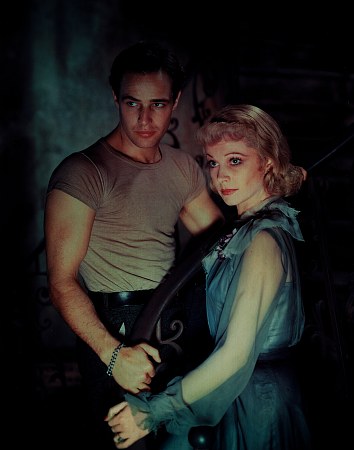 TOWER DISTRICT -- Every year, below a second
story balcony in New Orleans' fabled French Quarter, crowds
gather to watch men tear at their T-shirts in agony and shout at
the heavens. For the uninitiated bystander, such a ritual might
seem cultish, or perhaps simply overindulgent.
TOWER DISTRICT -- Every year, below a second
story balcony in New Orleans' fabled French Quarter, crowds
gather to watch men tear at their T-shirts in agony and shout at
the heavens. For the uninitiated bystander, such a ritual might
seem cultish, or perhaps simply overindulgent.
But to those who have taken in Tennessee
Williams' A Streetcar Named Desire, either on stage or on
screen, the spectacle exposes a far different meaning.
The 34th Anniversary of the
theatrical play version in Fresno is coming up soon. It appeared
on the community stage here on November 7, 1968.
Gordon Goede (Theatre Three) designed and
directed the show for its dramatic opening. Program Notes introduced
veteran community character actors Kelly Robbins (Stanley Kowalski),
Howard Hobbs (Mitch), Pat Fasler (Stella Kowalski), Jocelyn Dirks
(Blanche DuBois), W.B. Jones (Doctor), Tom Lopez (Pablo Sanchez),
Frank Robbins (Young Collector), Mary Piona (Nurse), Danna Card
(Eunice), Barbara Walls, (Woman).
To those men and women opening their hearts
and minds toward the stage and its open window, the name Stella
on the lips of Stanley, it's the opportunity to step into the shoes
of a dramatic legend.
A Streetcar Named Desire fueled
the legends of two of America's icons of drama: Tennessee Williams
and the star of his play, the 23-year-old Marlon Brando.
The play Williams created included a potent
mix of raw emotion and sex that would become what theater critics
would later call the best play of the 20th century.
Williams put the script through numerous
revisions under many working titles, including The Moth and
Blanche's Chair on the Moon. At the time he moved into an
apartment in New Orleans' French Quarter to finish his work on the
play, he was calling it The Poker Night. Kenneth Holditch,
who gives literary tours in New Orleans, says the location proved
inspirational.
"Williams said from that apartment he could
hear that rattletrap streetcar named Desire running along Royal,"
Holditch says, "and one named Cemeteries running along Canal. And
it seemed to him the ideal metaphor for the human condition."
That metaphor finds its expression within
the play in the character of Blanche DuBois -- originally played
by Jessica Tandy -- a fragile southern belle who visits her sister
Stella, played by Kim Hunter, and Stella's working-class husband
Stanley, played by Brando. Blanche, who hides a past not quite as
pure as she'd like people to imagine, complicates matters immediately.
Stanley suspects she's trying to swindle the couple.
In the play's brutal climactic scene, he
rapes Blanche, breaking her fragile grip on sanity. Williams used
more than just the name of a streetcar for inspiration.
It has been suggested by some scholars that Stanley
-- rough, masculine and short tempered -- was based on Williams'
lover homosexual partner at the time he was writing the play, a
man named Pancho Rodriguez Gonzalez.
Williams may have inserted himself into
the play as well, says his brother Dakin. "Blanche is Tennessee,"
Dakin insists. "If he would tell you something it wouldn't be necessarily
true. And Blanche says in Streetcar, 'I don't tell what's true,
I tell what ought to be true.' And so everything in Blanche was
really like Tennessee."
Williams' use of gender role-playing as
inspiration would surely have caused a stir had it been common knowledge
at the time. But so, the play raised eyebrows. Williams' frank presentation
of sexuality onstage shocked some audiences, but thrilled as many
others.
Philip Kolin, a professor of English and
author of several books on Streetcar, puts the magnitude of the
play in perspective. "People have said that Williams absolutely
invented the idea of desire for the 20th century," he says. "It
was a play that dealt with for the very first time on the American
stage, female sexuality and male sexuality."
When the curtains closed on the play's
first night on Broadway, on Dec. 3, 1947, the crowd shared a moment
of stunned silence, then burst into applause that lasted a full
30 minutes.
The play would go on to win the Pulitzer
Prize for Williams, and was made into a movie by Elia Kazan, with
help from the playwright and most of the original cast. The film
would help cement Streetcar's place in history, garnering 12 Academy
Award nominations -- Kim Hunter, Vivien Leigh (who replaced Jessica
Tandy as Blanche), and Karl Malden as Stanley's friend Mitch took
home statuettes for their performances, and the picture won for
best art direction.
Not all of the response was so positive,
but there was little that could be done to stop Streetcar's momentum.
The Catholic Legion of Decency, which functioned as a sort
of ratings board, threatened to condemn the film unless the more
overtly sexual scenes, including Stanley's rape of Blanche, were
removed.
Williams acquiesced on some counts and
wrote new dialogue that reduced the bisexuality of Blanche's husband
to subtext, but refused to take out the rape scene.
The Legion agreed, but only if Stanley
was shown suitably punished for his actions. But the complaints
did little to stop Streetcar's momentum. The film was released in
1951, and more than 50 years later, Stanley's cries echo still.
[Editor's Note: Here's an
audio discussion link on the
background of the production
A Streetcar Named Desire.]
COMMENT

TowerDistrictNews.com |
 |
| September
22, 2001
Gay Pride?
by Margaret Cho
TOWER DISTRICT -- As someone
whose odometer has turned over a couple of times, I tend to not
even go to Pride anymore. That comes from the part of me that thinks
gays are so everyday and so mainstream that Pride parades are a
big yawn.
At the same time, another reality hits
me in the face when I see evidence that there are still quite a
few people out there who hate queers. But is Gay Pride a good way
to change the hearts and minds of America? What do you think?
I had a friend who was very cynical and
every year would go into self-imposed exile in his apartment so
that he could "Hide from Pride!" Once the festivities were over,
he would emerge refreshed and ready to take on the world, and it
used to make me angry, like, "Queen, what's wrong with you! Why
you gotta be a Bitch Scrooge -- please!"
Then I realized that was how he would celebrate
Gay Pride, by relaxing and taking a couple of days to be alone and
contemplate his life and what his sexuality meant to him.
I think we have different opinions about Gay Pride,
and whether you are out there dancing shirtless under a tent, sharing
a lemonade with a drag queen or staying at home to avoid the crowds,
as long as you are doing something for yourself, you are observing
what I believe is a very important holiday.
I prefer getting out, seeing friends, checking
out hotties of all persuasions, eating bad food on a stick and getting
weird tan lines from my halter top. I want to cry when I see all
the gay men with their kids, old lesbians that you know have been
together for half a century, poppin' fresh trannies and all those
bisexuals with dream catcher earcuffs.
It makes me feel at home. It reminds me
of the place that I come from. It gives me hope for the future.
And we need hope right now. There have been many great strides in
the way that America views queer life, but it isn't like we have
complete acceptance.
Gay marriage is still not a reality. There
are states where gay couples cannot adopt children. Homophobia happens.
There is no cure for AIDS. We have some wonderful gays and lesbians
in office, a couple of hot gay characters on TV, but we are far
from true equality.
Celebrating ourselves helps us recognize
and utilize our political power. Plus, it can be a lot of fun. So
go out this year. Put on some sunblock, stuff some condoms in your
pocket and have a good time. For yourself, and for all of us.
COMMENT

TowerDistrictNews.com |
 |
SLOW
DOWN FOR GOD'S SAKE!
OFFICIAL TOWER SPEED BUMP |
September 11, 2002
A Modest Proposal
Turn Residents Into Mobile Speed Bumps!
By Tower District News Staff
FRESNO -- The Neighborhood
Pace Car Program is an exciting new citizen based initiative
that promises to slow traffic and reduce car use.
The idea originated in Boise, Idaho and
is being implemented in cities like Palo Alto and Santa Cruz.
This idea is ingenious and simple; it uses
neighborhood residents' cars to calm drivers who are "just
passing thru" merely by encouraging motorists to abide by existing
laws.
This program promotes safe and courteous
driving. The two elements of this program are a bumper sticker and
a personal commitment by Tower District residents to become mobile
speed bumps. Local motorists are asked to sign a pledge and implement
it into their driving habits and lifestyles.
A bumper sticker would then be attached
tpo their front and rear bumpers that would identify them as "Mobile
Speed Bumps". As a pace car driver, residents and their
neighbors become "mobile speed humps."
The central core of this program is that
it puts the responsibility to drive within posted speed limits on
the motorist, therefore we encourage all the residents of the Tower
District to take the pledge by driving safely within posted speed
limits and by pasting the following bumber sticker in a conpicuous
place on the rear of your vehicle. Then go for a drive around the
neighborhood and be happy!

TowerDistrictNews.com |
| |
| September10,
2002
ROCK AROUND THE TOWER
By Suzy Menkes
LONDON --I call it Kids
Rule - we are all so young, and youth is the cool factor,"
says Jade Jagger as she prepares to rock the Tower of London to
its ancestral foundations.
On Thursday, Garrard, the crown jeweler,
will stage a party, orchestrated by Jagger, who is the creative
director of a store that is shaking off its establishment image
to become a mover and shaker in the luxury market..
The rapper Missy Elliott, the actor Rupert
Everett, the model Liberty Ross and Jagger herself will be the poster-size
faces of the jeweler that has furnished the British royal family
with baubles since the company was founded in 1735.
The Tower of London bash, where the Sugar
Babes will play a gig and Elton John - uncrowned king of the tiara
- is expected to put in a guest appearance, is to celebrate Garrard's
new London store.
Jagger has worked with the architect Tom
Bartlett to counteract what she calls the "austere and ostentatious"
interior of traditional jewelers. That means a store bathed in natural
light, shiny stainless steel and mirrors, softened with celadon
green and hot raspberry, Garrard's new signature color. Jagger has
added a bar ("to serve champagne") and plans computer
games and Internet access.
The client focus will include the rock and
pop world that Jagger was born into 30 years ago as the daughter
of Mick and Bianca Jagger. "I love the music industry - R&B,
hip-hop and reggae - and the musicians behind that work are the
only people ready to wear jewelry and to be proud and brandish it,"
says Jagger, whose personal vision is of wearing jewelry "with
casual, funky Balenciaga trousers," like the blood-red spinel
she has teamed with white top and pants (after the diamond gun pendant
came off because it weighed down her neck)..
Behind the fun and games is an investment
of £5 million ($7.9 million) in the store, which returns Garrard
to its earlier home at 24 Albemarle Street. (near Bond Street).
Its heavy-hitter backers are Lawrence Stroll and Silas Chou, formerly
investors in Tommy Hilfiger, who bought Garrard and the fellow jeweler
Asprey in July 2000 from Prince Jefri Bolkiah, the younger brother
of the Sultan of Brunei.
More recently, Edgar Bronfman and the Luxembourg-based
Tag Group - a holding company and former owner of Tag Heuer watches
- have come on board, hoping to turn the modest revenues of Asprey
and Garrard ($70 million in the fiscal year that ended in March
2001) into a $150 million company for Garrard alone over the next
five to eight years..
Gianluca Brozzetti, formerly of Louis Vuitton
and for 13 years with Bulgari, is the global CEO of Garrard, the
man who has put his trust in Jagger and surrounded her with a team
of thirtysomethings. They include Francesca Amfitheatrof (jewelry),
Tamsin de Roemer, (accessories), Koji Tatsuno (fashion) and Omar
Torres (jewels).
"British classical and avant-garde
- that is the mission," Brozzetti says. "First of all,
there are engagement rings, but we will also take jewelry into new
territories."
He was referring to the Garrard "eternal"-cut
multi-faceted diamond and to jeweled "couture," from gem-studded
belts and bags, such as a white silk purse encrusted with pearls
to racier gold-mesh underpants.
"Jewelry is the emblem of the house and it has a very great
history - but we have to rebuild awareness," Brozzetti said.
Jagger aims to burnish the heritage, with
jewelry incorporating the "G"-and-crown monogram that
traditionally hallmarked Garrard's silver and with inspiration from
the "knightrider" collection with medieval heraldic emblems.
Garrard is rebranding just as jewelry is
undergoing an upheaval to parallel high fashion under major luxury
groups. LVMH (Moet Hennessy Louis Vuitton) will unveil in London
this autumn its first store in a joint venture with De Beers, while
Boucheron, part of Gucci Group, is repositioning with a young fashion-aware
designer. All long to mirror the success of Tiffany.
Brozzetti admits that even Asprey - at one
point merged with Garrard and soon to be relaunched as a "lifestyle"
brand - will be a competitor. But after a financial drop in 2002,
because of stock clearance and rebuilding, he expects the efforts
to pay dividends for Garrard by mid 2003.
"But it would be silly to make projections,"
Brozzetti says. "The market is very competitive."
COMMENT
Copyright 2002. International Herald Tribune. All
Rights Reserved. |
| |
| The Steinbeck Trivium -- The California
Steinbeck Syllabus and Tower Writer's Institute. 1962
Nobel Prize -- Steinbeck Syllabus
|
 |
| Responses to Uncertainty in a Complex World
-- Persons respond in a variety of ways to to the stresses that
uncertainty causes in their lives. This, in recent years, has led
to polarization in: legislative bodies of government, political
parties, school boards -- Postmodern
World |
 |
| The Original One & Only Well Built Web Page! -- The Tower
District and its updated News web site appeal to the senses. A
place to walk, bike, browse and enjoy. Sip coffee, stroll through
our celebrated hundred acre City College Campus, visit our Off Broadway
theatres and ArtDeco College Pharmacy, Visit Club Fred,
eat a Chicken Pie, view some art, have some fun! Every season
has its charms here - Well Built
Web Page! |
 |
| John Steinbeck East of Eden Notes -- John
Steinbeck's East of Eden was published for the first time
by Viking Press in September 1952, ten years before the writer was
awarded the Nobel Prize for Literature, and has never
been out of print since. In November 1952 East of Eden was
number one on the fiction best-seller list -- East
Eden Notes |
 |
| Judgment at Nuremburg Theatre Review --
Judgment at Nuremburg, which opened last night at the Longacre
Theatre, is Abby Mann's stage adaptation of his teleplay
and subsequent screenplay about war guilt, responsibility, and accountability;
specifically the trials of several Nazi judges for their complicity
in Nazi atrocities and the Holocaust. It’s a serious subject
with implications which are as timely today as they have been for
the last 60 years -- Nuremburg
|
 |
| The Thought and the Act of Writing In 21st
Century -- Visit the Tower Writer's Institute -- Language
& Thought |
 |
Once
Upon A More Enlightened Time
Today's Tower District Has Forgotten
Its Own! What is
the Tower District? My friend William Saroyan defined it. He invented
it. And now people who cannot answer the first question -- Who
was William Saroyan? |
 |
| Benefit & The Burden: The Business Organization
Tax Exemption!
Is your business eligible for
a tax exemption? Section 501(c)(6) of the Tax Code provides for
the exemption from Federal income tax if organization members of
a particular industry want to join together to develop new and improved
uses for existing products of the industry.
To qualify for non-profit status, your
business group’s activities should be directed to the improvement
of business conditions. Keep in mind that none of the money can
be used to improve performance of particular services for individual
persons. Since your organization's activities are directed towards
improving the business conditions of the organization, in general,
your organization can apply to obtain the Federal income tax exemption
under section 501(c)(6) of the Tax Code.
First you may want to consider incorporating
the organization and obtaining a charitable standing with the California
Secretary of State and the U.S. Attorney General. Make sure you
file tax returns promptly on all sales that are used to pay for
advertising in newspapers, promos on TV and Radio. Some members
in your business group may think the organization is within the
scope of the Tax Code, and doesn’t have to file papers with the
IRS. Don’t buy it.
And if your business group plans to sell
items to the public, alcohol, tickets for performances, or any promotional
merchandise, your business group must keep accurate accounting records,
have a valid business license, and pay income taxes on profits.
The Revenue Rulings require every group, including yours, to file
an application on Form 1024, Exemption Application, in order to
be recognized by the Service as exempt under section 501(c)(6) of
the Code. The application should be filed immediately and before
announcing the group is “tax-exempt”. It must be filed with the
District Director of Internal Revenue for the district in which
is located the principal place of business or principal office of
the organization. See section 1.501(a)-1 of the regulations. |


|
|
 |
|

Now
Playing!
_________________

Tower City Cam
_________________

Community
Calendar
_________________
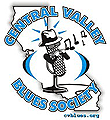
Central
Valley
Blues Society
_________________

Valley
Weather
_________________

Fresno Gas
Prices
|
|





